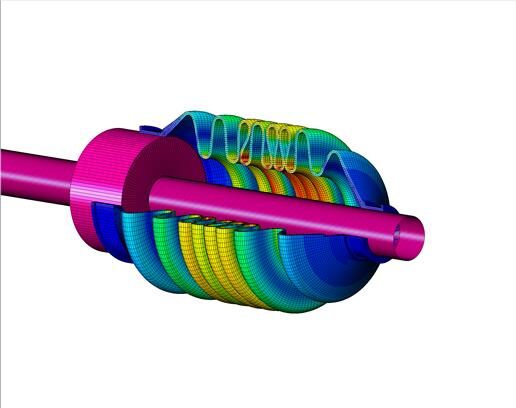What is nonlinear FEA?
Posted on 14/04/2021 Category: Technical Features

We often get asked what the difference is between linear and nonlinear FEA. Linear FEA is the perfect tool for the job it is designed for. But it is much simpler than nonlinear FEA.
Picture this: it’s Saturday lunchtime, you’ve spent the morning working out – a run, a swim, hell, let’s make it a triathlon. You need to eat something substantial but you are short on time. You grab a pre-made lasagne from the fridge and read the instructions; you pierce a few holes in the lid, check your microwave’s power rating and shove it in. Bing! Sorted. That’s linear analysis. Perfect for the job it was designed for, easy to use and the output is exactly what you were expecting.
Then Sunday comes around. The in-laws are coming for lunch and so is your brother and his kids. The lasagne might have been easy but it won’t cover the varying needs of your guests and anyway, the microwave won’t fit that many meals all at once. You’ve found numerous recipes for the beef steak that you’ve bought, all suggesting different timings – and each person wants it cooked differently. You’re roasting three types of veg that each need the oven at a different temperature and so you’re trying to estimate how the volume of food, water content and temperature will affect the results. And your brother’s just poured half a bottle of red wine into the sauce ‘for good measure’. That’s nonlinear analysis. Okay, it’s not – but it was the closest analogy we could come up with (please don’t write in to point out the flaws!) We hope what you take from it is the difference in both scale and complexity when compared to the ‘linear’ microwave meal above; we’re not knocking linear FEA as it is the perfect solution for the job it’s designed for, it’s simply very different to run than nonlinear FEA.
Now for the technical bit: what is nonlinear FEA?
A nonlinear analysis is needed when there is a nonlinear relationship between the forces and the subsequent displacements of a product or structure – in other words, within hyperelastic materials where the elastic deformation can be very large. In engineering terms, nonlinear FEA can relate to both material and geometric nonlinearity (such as high elongation). In a linear analysis, the stiffness matrix remains constant until a predictable failure point.
A more user-friendly explanation? Linear materials such as metals can be evaluated with simpler equations; the response to stresses and strains are well documented, understood and can be easily predicted – this is FEA as most of us know it. As with all things, there are exceptions to this simulation technique, and, given our love of all things rubber related, it will come as no surprise to you to find that we’ll be talking in more detail specifically about nonlinear FEA when applied to materials that exhibit hyperelasticity (rubbers and plastics).
Why is nonlinear FEA so specialised?
The kind of engineering simulation facilitated by FEA has become a fundamental part of the design and development process in most product development cycles, and students leaving university now are generally familiar with linear simulation techniques. Even if (don’t worry – we won’t tell) you finished your degree before CAD packages that included linear FEA software were available, most mechanical engineers worth their salt nowadays know how to use standard FE analysis to simulate the performance of a component in situ.
Nonlinear FEA, however, is not often taught in most undergraduate engineering courses because such a detailed knowledge of rubbers is required to conduct an accurate nonlinear analysis. So, if you’re wondering why your engineering team isn’t able to pull a nonlinear FE analysis out of the bag for a rubber component, don’t give them a hard time – it’s a pretty niche area!
How is nonlinear FEA used?
The basic reason behind performing either type of FEA is the same: to simulate a product’s performance prior to manufacture, or to understand why an existing product is failing in application. However, whereas most engineering teams will carry out their own linear FE analysis, due to the specialism that non-linear FEA requires, the service is usually outsourced to those with expertise. We find that there are a range of reasons that engineers come to us wanting nonlinear FEA; the requirement usually falls into one of four camps:
To validate a design
This can be a justification for a project sign-off, release of funding or simply part of a standard engineering design process within an organisation to avoid unnecessary re-manufacture. If a similar part is in existence and is known to perform satisfactorily, then it may be that non-linear FEA is called upon to demonstrate the (already known) likely performance of the new version.
To facilitate design improvements
Some customers are looking for us to work with them in redesigning areas that show a stress/strain impact. Others like to keep complete design control, and request a report so that the changes can be made in-house; we are then supplied with a new iteration of the design for analysis.
Full design support
For some clients, particularly on parts such as boots, gaiters and AV mounts for motorsport, a component’s purpose and its performance requirements are already well understood. What linear FEA is used for in these situations is part of a full design package; our customer provides us with a set of parameters and a space into which that product must fit, and we support them with a finished design, proven through simulation.
Failure analysis
FEA can be used to analyse a failure mode on a part that has failed in service, and objectively assess and reverse engineer proposed improvements to the design, or to the materials used.
What is the difference between linear and nonlinear FEA software packages?
Linear FEA is included on most standard CAD packages and can be run once the modelling of a part is complete. Some CAD packages also include non-linear FEA programmes. However, in software such as SolidWorks and Autodesk, the options they provide only run to around 5% elastic strain, whereas the majority of rubber products will experience a larger strain than this in application, making this kind of functionality redundant for elastomers.
Software designed specifically for non-linear FEA rarely performs any other function; the mathematical modelling is complex enough that a full package can be dedicated to this process alone. A significant amount of computer power is needed to run these simulations – the upshot being that they are neither cheap, nor straightforward to use. There are software options available which don’t offer the option to visually review the calculated deformation modes, which can make curve fitting much more of a guessing game and can therefore introduce inaccuracies into the final result.
How does the user experience differ between linear and nonlinear FEA?
Whilst choosing appropriate software is critical to providing accurate outputs, the user must be able to understand and interpret those results. If you are unfamiliar with the expected curve fits for the deformation modes of a given material, or you lack the understanding of the bulk modulus, it is possible that one of the outputs could be wrong by a factor of ten. Not only would such a dramatic misrepresentation affect the overall result and what it is telling you, it wouldn’t be obvious to you if you didn’t know what you were looking at because the correlation appears to make sense on first sight.
If you are developing a rubber product and want to understand its performance prior to manufacture, there are no short-cuts. To get meaningful results, you must use the right software and have a full understanding of your material. In our opinion, it’s a no-brainer; why wouldn’t you do the simulation up front and save time and money on manufacturing? If you’d like to know more about the difference between linear and nonlinear and how nonlinear FEA could work for you, get in touch with us on [email protected] or call 023 8022 6330.


